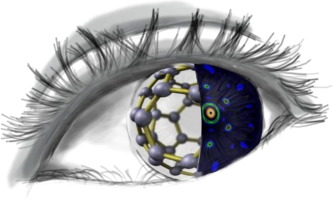当前位置:
X-MOL 学术
›
Prog. Mater. Sci.
›
论文详情
Our official English website, www.x-mol.net, welcomes your feedback! (Note: you will need to create a separate account there.)
Watching nanomaterials with X-Ray eyes: probing different length scales by combining scattering with spectroscopy
Progress in Materials Science ( IF 37.4 ) Pub Date : 2020-07-01 , DOI: 10.1016/j.pmatsci.2020.100667 Cinzia Giannini , Vaclav Holy , Liberato De Caro , Lorenzo Mino , Carlo Lamberti
Progress in Materials Science ( IF 37.4 ) Pub Date : 2020-07-01 , DOI: 10.1016/j.pmatsci.2020.100667 Cinzia Giannini , Vaclav Holy , Liberato De Caro , Lorenzo Mino , Carlo Lamberti

|
Abstract Everybody dreams to have X-ray eyes and discover the most invisible secrets of the world around us. X-rays can probe matter (depth resolved) down to atomic resolution, if relying on diffraction-based techniques. An X-ray diffraction pattern may contain information over many length scales (atomic structure, microstructure, mesostructure). This peculiarity justifies the well-recognized impact of several X-ray diffraction-based techniques to diverse fields of research. On the other hand, X-ray spectroscopies (both in absorption and in emission) provide insights on the electronic structure and, exploiting element selectivity and local environment, can complement or even replace scattering techniques for diluted systems and amorphous materials. Herein, we provide a theoretical foundation which spans from very basic concepts, through well-known techniques, with applications to nanomaterials research. An increasing level of material complexity is explored: size and shape analysis of nanoparticles dispersed in solution or single nanostructures localized onto surfaces; local morphology/strain analysis of nanostructured surfaces; average defects analysis of stacking faulted nanocrystals; regular 2D and 3D lattices of self-assembled nanocrystals; clusters of nanocrystals without any nanoscale lattice order, standing alone as isolated objects or embedded in tenths-of-µm-thick polymers (here coherent and focused X-rays are mandatory to explore the spatial inhomogeneity and lattice (in)coherence of the materials).
中文翻译:

用 X 射线眼睛观察纳米材料:通过结合散射和光谱来探测不同的长度尺度
摘要 每个人都梦想拥有 X 光眼,发现我们周围世界最不可见的秘密。如果依赖基于衍射的技术,X 射线可以探测物质(深度解析)到原子分辨率。X 射线衍射图可能包含许多长度尺度(原子结构、微观结构、细观结构)的信息。这种特性证明了几种基于 X 射线衍射的技术对不同研究领域的公认影响是合理的。另一方面,X 射线光谱(吸收和发射)提供了对电子结构的洞察,并且利用元素选择性和局部环境,可以补充甚至取代稀释系统和非晶材料的散射技术。在这里,我们提供了一个理论基础,它涵盖了非常基本的概念,通过众所周知的技术,应用于纳米材料研究。探索了越来越多的材料复杂性:分散在溶液中的纳米颗粒或位于表面的单个纳米结构的尺寸和形状分析;纳米结构表面的局部形态/应变分析;层错纳米晶体的平均缺陷分析;自组装纳米晶体的规则 2D 和 3D 晶格;没有任何纳米级晶格顺序的纳米晶体簇,作为孤立的物体独立存在或嵌入在十分之一微米厚的聚合物中(这里必须使用相干和聚焦 X 射线来探索材料的空间不均匀性和晶格(不)相干性) . 分散在溶液中的纳米颗粒或位于表面的单个纳米结构的尺寸和形状分析;纳米结构表面的局部形态/应变分析;层错纳米晶体的平均缺陷分析;自组装纳米晶体的规则 2D 和 3D 晶格;没有任何纳米级晶格顺序的纳米晶体簇,作为孤立的物体独立存在或嵌入在十分之一微米厚的聚合物中(这里必须使用相干和聚焦 X 射线来探索材料的空间不均匀性和晶格(不)相干性) . 分散在溶液中的纳米颗粒或位于表面的单个纳米结构的尺寸和形状分析;纳米结构表面的局部形态/应变分析;层错纳米晶体的平均缺陷分析;自组装纳米晶体的规则 2D 和 3D 晶格;没有任何纳米级晶格顺序的纳米晶体簇,作为孤立的物体独立存在或嵌入在十分之一微米厚的聚合物中(这里必须使用相干和聚焦 X 射线来探索材料的空间不均匀性和晶格(不)相干性) .
更新日期:2020-07-01
中文翻译:

用 X 射线眼睛观察纳米材料:通过结合散射和光谱来探测不同的长度尺度
摘要 每个人都梦想拥有 X 光眼,发现我们周围世界最不可见的秘密。如果依赖基于衍射的技术,X 射线可以探测物质(深度解析)到原子分辨率。X 射线衍射图可能包含许多长度尺度(原子结构、微观结构、细观结构)的信息。这种特性证明了几种基于 X 射线衍射的技术对不同研究领域的公认影响是合理的。另一方面,X 射线光谱(吸收和发射)提供了对电子结构的洞察,并且利用元素选择性和局部环境,可以补充甚至取代稀释系统和非晶材料的散射技术。在这里,我们提供了一个理论基础,它涵盖了非常基本的概念,通过众所周知的技术,应用于纳米材料研究。探索了越来越多的材料复杂性:分散在溶液中的纳米颗粒或位于表面的单个纳米结构的尺寸和形状分析;纳米结构表面的局部形态/应变分析;层错纳米晶体的平均缺陷分析;自组装纳米晶体的规则 2D 和 3D 晶格;没有任何纳米级晶格顺序的纳米晶体簇,作为孤立的物体独立存在或嵌入在十分之一微米厚的聚合物中(这里必须使用相干和聚焦 X 射线来探索材料的空间不均匀性和晶格(不)相干性) . 分散在溶液中的纳米颗粒或位于表面的单个纳米结构的尺寸和形状分析;纳米结构表面的局部形态/应变分析;层错纳米晶体的平均缺陷分析;自组装纳米晶体的规则 2D 和 3D 晶格;没有任何纳米级晶格顺序的纳米晶体簇,作为孤立的物体独立存在或嵌入在十分之一微米厚的聚合物中(这里必须使用相干和聚焦 X 射线来探索材料的空间不均匀性和晶格(不)相干性) . 分散在溶液中的纳米颗粒或位于表面的单个纳米结构的尺寸和形状分析;纳米结构表面的局部形态/应变分析;层错纳米晶体的平均缺陷分析;自组装纳米晶体的规则 2D 和 3D 晶格;没有任何纳米级晶格顺序的纳米晶体簇,作为孤立的物体独立存在或嵌入在十分之一微米厚的聚合物中(这里必须使用相干和聚焦 X 射线来探索材料的空间不均匀性和晶格(不)相干性) .


























 京公网安备 11010802027423号
京公网安备 11010802027423号